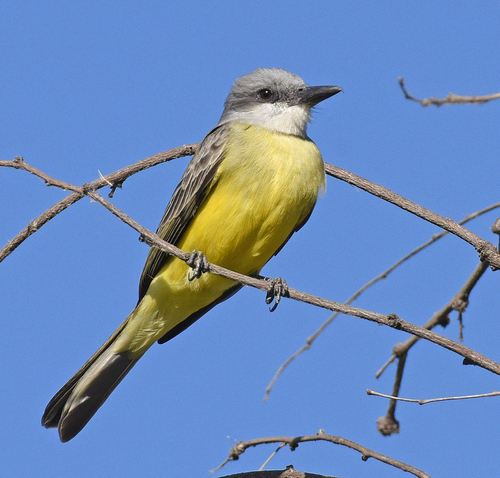
Tropical Kingbird
The Tropical Kingbird (*Tyrannus melancholicus*) is a widespread and conspicuous flycatcher found throughout much of the Americas. Known for its assertive behavior and distinctive calls, this species plays a vital role in controlling insect populations within its range. While not particularly colorful, its bold personality and adaptability have made it a familiar sight in both rural and urban environments. It is not currently considered globally threatened, but localized habitat loss can impact populations.
20-24 cm
Length
33-38 cm
Wingspan
Least Concern
Conservation Status
Distribution
The Tropical Kingbird's range extends from the southern United States (Arizona, Texas) through Mexico, Central America, and into most of South America, as far south as central Argentina. It is largely non-migratory in its core range, but populations at the northern and southern extremes may undertake seasonal movements.
Lifespan
Information on lifespan in the wild is limited, but likely ranges from 4-8 years, typical for similar-sized passerines.
Tropical Kingbird's Habitat
Habitat Types
Open woodlands, Savannas, Forest edges, Agricultural areas, Urban parks, Roadsides
Climate Zones
Tropical, Subtropical, Temperate (in some parts of its range)
Adaptations
The Tropical Kingbird is highly adaptable to disturbed habitats, often perching on exposed branches, wires, or fences to gain a clear view for hunting. Its generalist diet allows it to thrive in a variety of environments.
Variations
Several subspecies are recognized, differing slightly in size and plumage coloration. These variations are generally subtle and reflect geographic isolation.
Appearance
Breeding Plumage
Plumage is generally consistent year-round.
Seasonal Feather Changes
No significant seasonal variation.
Sex Based Plumage Differences
Males and females have similar plumage.
Notable Features
Grayish-olive upperparts, Pale gray head with a slightly darker mask through the eye, Yellowish underparts, particularly on the belly, Concealed orange-red crown patch (usually only visible when agitated), Long, notched tail
Diet and Feeding
Primary Foods
Insects, Small fruits, Berries
Foraging Behavior
The Tropical Kingbird is primarily an aerial insectivore. It typically perches on an exposed vantage point and sallies out to capture flying insects in mid-air. This behavior is known as 'hawking'. They also occasionally glean insects from foliage or consume fruit.
Specializations
Their wide gape and maneuverable flight are adaptations for capturing flying insects.
Seasonal Diet Variations
The proportion of insects and fruit in the diet may vary seasonally depending on availability. During the breeding season, insects likely form a larger part of the diet to provide protein for growing chicks.
Behavior
Social Structure
Tropical Kingbirds are generally solitary or found in pairs, especially during the breeding season. They may form small, loose flocks outside of the breeding season.
Communication
Loud, sputtering calls, often described as 'kip' or 'kip-kip-kip-kreeeer', Rapid chattering, Visual displays involving the crown patch and wing movements
Migration
Most populations are resident, but some at the extreme northern and southern edges of the range may migrate short distances to avoid harsh winters or to follow food resources.
Territorial or Group Behaviors
Highly territorial during the breeding season, aggressively defending nesting and feeding areas from other kingbirds and even larger birds. This aggressive behavior gives the kingbird its name.
Conservation
Threats
Habitat loss (deforestation, urbanization), Pesticide use (reducing insect prey), Collisions with vehicles
Protection Programs
General bird conservation efforts, such as habitat preservation and promoting sustainable agriculture, Monitoring programs to track population trends
Local National Laws
Protected under the Migratory Bird Treaty Act in the United States and similar legislation in other countries.
Population Trend
Stable
Population Estimates
The global population is estimated to be around 50 million individuals.
Interesting Facts
They are known for their fearless attacks on much larger birds, including hawks and vultures.
This aggressive behavior is used to defend their territory and nest from potential predators.
The 'kingbird' name refers to their aggressive temperament, not their size.
They are relatively small birds, but their boldness gives them a 'kingly' presence.
They can sometimes be seen 'anting,' rubbing ants on their feathers.
This behavior is thought to help control parasites or soothe skin irritation.
Faqs about Tropical Kingbird
Are Tropical Kingbirds harmful to gardens?
No, they are primarily beneficial as they consume large numbers of insects, many of which are considered garden pests. They may occasionally eat small fruits, but the benefits of their insect control generally outweigh any minor damage.
What should I do if I find a baby Tropical Kingbird?
If the bird is uninjured and appears healthy, it is best to leave it alone. The parents are likely nearby and will continue to care for it. If the bird is injured or in immediate danger, contact a local wildlife rehabilitator. *Consult a professional for medical or expert advice.*
How can I attract Tropical Kingbirds to my yard?
Provide open areas with perching opportunities (trees, shrubs, wires). Avoid using pesticides, as these reduce their food supply. A bird bath can provide a source of water.
Copyright @ Nature Style Limited. All Rights Reserved.
 English
English